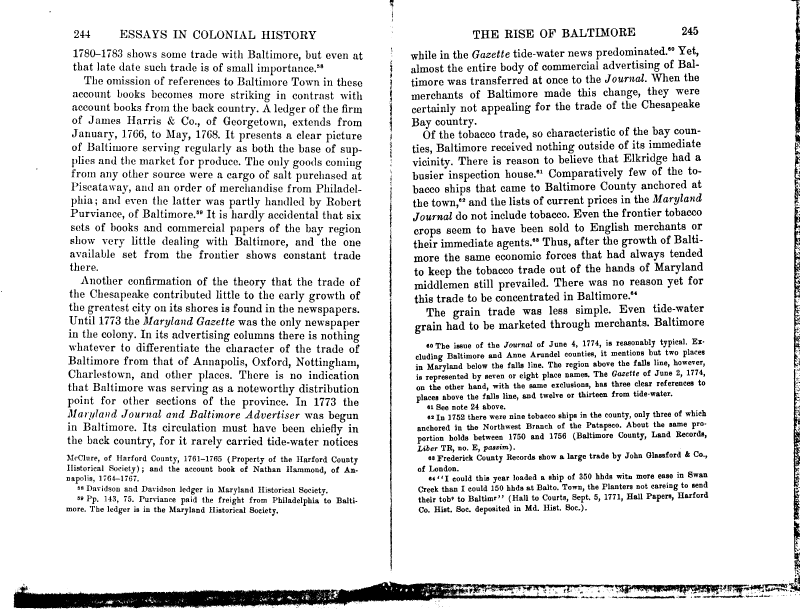|
244
ESSAYS IN COLONIAL HISTORY
THE RISE OF BALTIMORE
245
1780-1783 shows some trade with Baltimore, but even at
that late date such trade is of small importance.58
The omission of references to Baltimore Town in these
account books becomes more striking in contrast with
account books from the back country. A ledger of the firm
of James Harris & Co., of Georgetown, extends from
January, 1766, to May, 1768. It presents a clear picture
of Baltimore serving regularly as both the base of sup-
plies and the market for produce. The only goods coming
from any other source were a cargo of salt purchased at
Piscataway, and an order of merchandise from Philadel-
phia ; and even the latter was partly handled by Robert
Purviance, of Baltimore.69 It is hardly accidental that six
sets of books and commercial papers of the bay region
show very little dealing with Baltimore, and the one
available set from the frontier shows constant trade
there.
Another confirmation of the theory that the trade of
the Chesapeake contributed little to the early growth of
the greatest city on its shores is found in the newspapers.
Until 1773 the Maryland Gazette was the only newspaper
in the colony. In its advertising columns there is nothing
whatever to differentiate the character of the trade of
Baltimore from that of Annapolis, Oxford, Nottingham,
Charlestown, and other places. There is no indication
that Baltimore was serving as a noteworthy distribution
point for other sections of the province. In 1773 the
Mart/laud Journal and Baltimore Advertiser was begun
in Baltimore. Its circulation must have been chiefly in
the back country, for it rarely carried tide-water notices
McClure, of Harford County, 1761-1765 (Property of the Harford County
Historical Society); and the account book of Nathan Hammond, of An-
napolis, 17G4—1767.
»8 Davidson and Davidson ledger in Maryland Historical Society.
»8 Pp. 143, 75. Purviance paid the freight from Philadelphia to Balti-
more. The ledger is in the Maryland Historical Society.
while in the Gazette tide-water news predominated.80 Yet,
almost the entire body of commercial advertising of Bal-
timore was transferred at once to the Journal. When the
merchants of Baltimore made this change, they were
certainly not appealing for the trade of the Chesapeake
Bay country.
Of the tobacco trade, so characteristic of the bay coun-
ties, Baltimore received nothing outside of its immediate
vicinity. There is reason to believe that Elkridge had a
busier inspection house." Comparatively few of the to-
bacco ships that came to Baltimore County anchored at
the town,'2 and the lists of current prices in the Maryland
Journal do not include tobacco. Even the frontier tobacco
crops seem to have been sold to English merchants or
their immediate agents.8* Thus, after the growth of Balti-
more the same economic forces that had always tended
to keep the tobacco trade out of the hands of Maryland
middlemen still prevailed. There was no reason yet for
this trade to be concentrated in Baltimore.84
The grain trade was less simple. Even tide-water
grain had to be marketed through merchants. Baltimore
•o The issue of the Journal of June 4, 1774, is reasonably typical. Ex-
cluding Baltimore and Anne Arundel counties, it mentions but two places
in Maryland below the falls line. The region above the falls line, however,
is represented by seven or eight place names. The Gazette of June 2, 1774,
on the other hand, with the same exclusions, has three clear references to
places above the falls line, and twelve or thirteen from tide-water.
«i See note 24 above.
«2 In 1752 there were nine tobacco ships in the county, only three of which
anchored in the Northwest Branch of the Patapsco. About the same pro-
portion holds between 1750 and 1756 (Baltimore County, Land Records,
Liber TB, no. E, passim).
«» Frederick County Records show a large trade by John Olassford & Co.,
of London.
«<"I could this year loaded a ship of 350 hhds witn more ease in Swan
Creek than I could 150 hhds at Balto. Town, the Planters not careing to send
their tob» to Baltimr" (Hall to Courts, Sept. 5, 1771, Hall Papers, Harford
Co. Hist. Soc. deposited in Md. Hist. Soc.).
|

